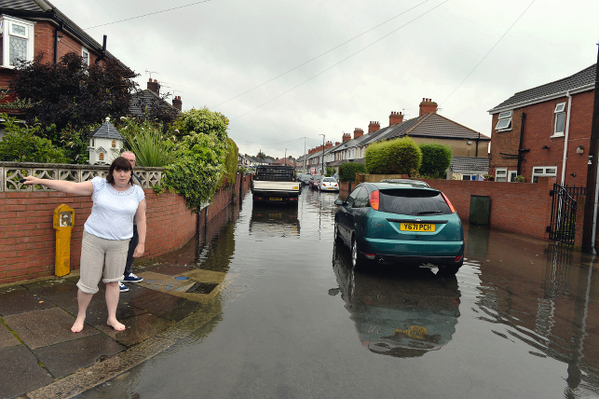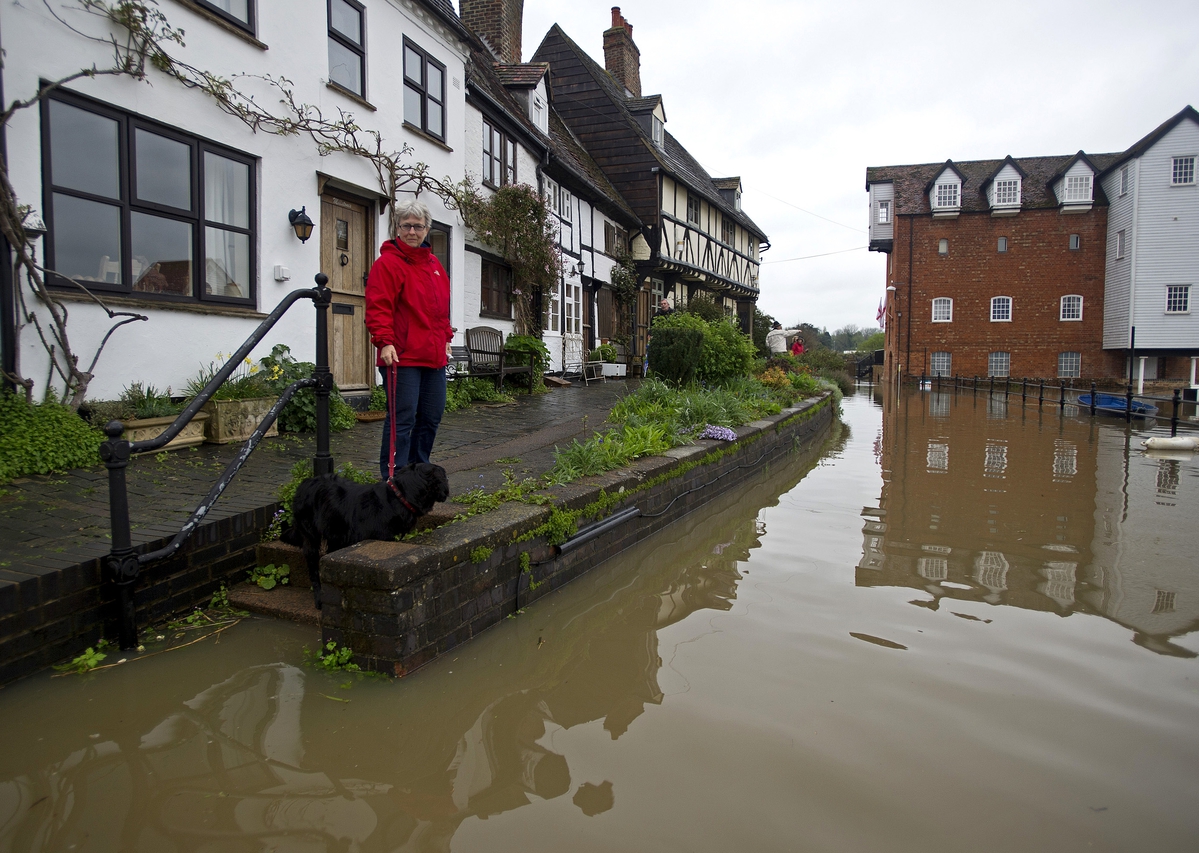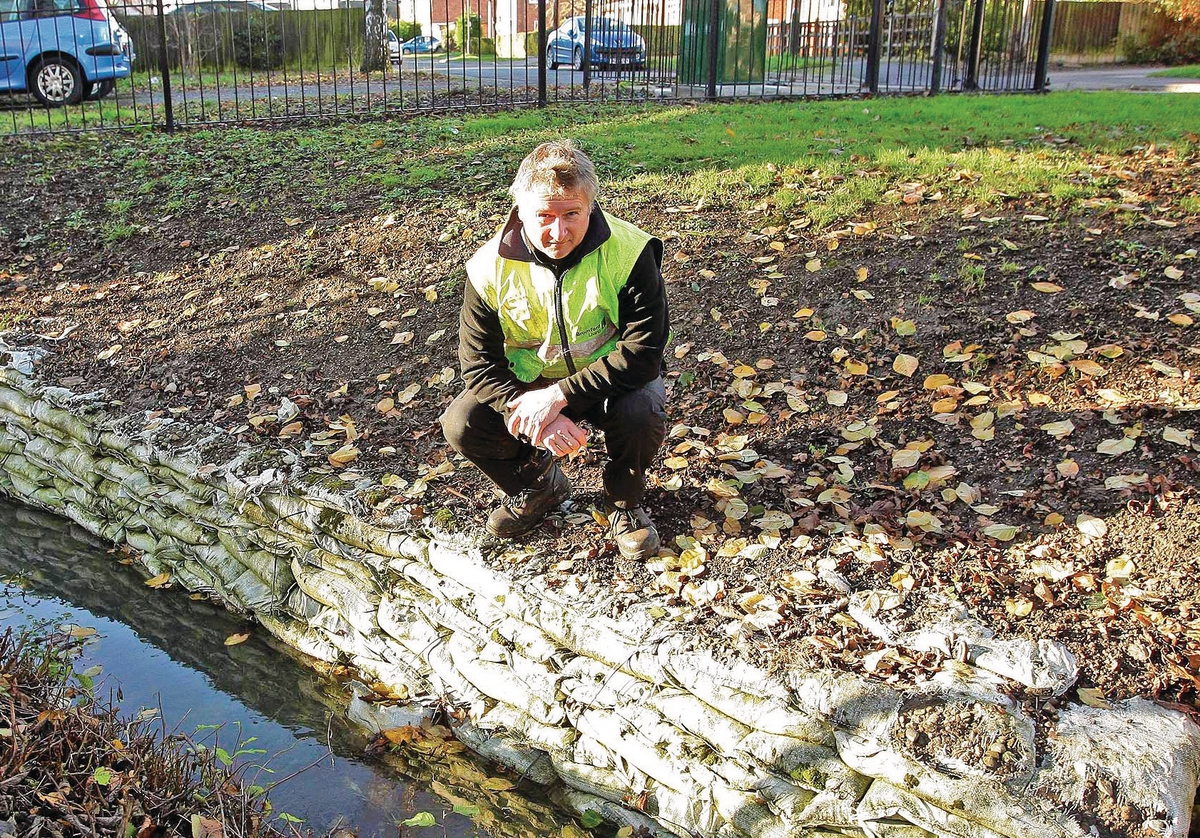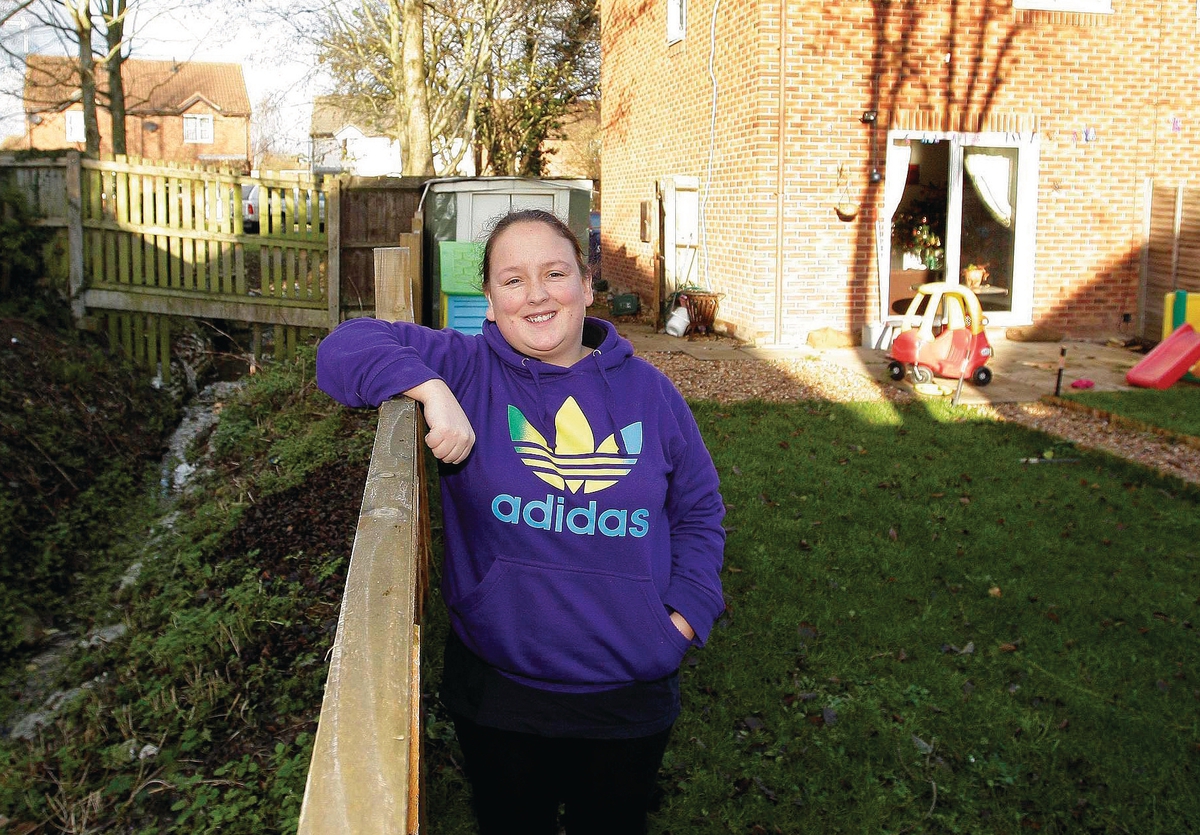The flood squad
Bromford Group’s stock was hit hard by flooding in 2007, but when the waters rose again recently, things had changed. Alex Turner joins the landlord’s landscaping team to find out why
On a bitterly cold December morning, there’s barely a puddle to be seen on the flood-plain fields surrounding Tewkesbury - and the ice-blue sky doesn’t look inclined to change that state of affairs.
The picture is similarly innocuous at Fairway, a neat cul-de-sac of modern, semi-detached homes near Ashchurch railway station on the outskirts of the Gloucestershire town. A sluggish brook trickles its way down the middle of the street, barely a metre wide and sitting low in its culvert.
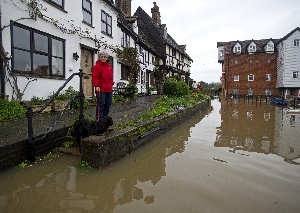
Floodwater rises in Tewkesbury, April 2012
But a week previously, as torrential rain sluiced across much of the UK and waters rose rapidly, tenants living on Fairway feared they were in for a repeat of the 2007 floods, when the culvert spilled its contents into homes on the lower-lying side of the street.
That summer, Bromford Group recorded 142 incidents of flooding in its properties across England, against a backdrop of 55,000 affected nationally, resulting in insurance claims of more than £1.8 million. Many tenants did not have home contents cover (Bromford now signposts customers towards a partnership policy), and the worst affected were unable to return home for six months.
This time things were different. Although Gloucester received 156mm of rain during November - nearly twice its long-term average - just two properties suffered water damage. Today Inside Housing is meeting Ian Williamson, who leads Bromford’s 10-strong south area landscaping team, to find out how successful the 27,000-home organisation has been at improving the lot of its at-risk tenants.
Following the widespread disruption and misery to residents five-and-a-half years ago, Bromford ‘saw significant improvements that otherwise wouldn’t have been done’, Jason Holder, the landlord’s head of repairs, tells Inside Housing.
‘Severn Trent [Water], the local authorities - everyone had the same “we can’t let this happen again” mentality and were able to put pressure on [themselves to do] physical works.’
In Bromford’s case, these works included constructing boundary walls, installing non-return valves on drainage pipes to watercourses and reviewing the effectiveness of drainage ditches. And in order to keep on top of the situation, flood prevention has become an ongoing process - with the landscaping team playing a crucial role.
‘There were so many [instances] where flooding was found to be a result of natural watercourses not running clear,’ Mr Holder continues. ‘Basically, the water has nowhere to go.’
This is precisely the worry at Fairway where, Mr Williamson explains, the culvert easily becomes clogged with leaves and other debris. It was widened following the flooding of the street, dredged again in 2010, and further work has since been carried out to improve the situation, including cutting back surrounding trees to reduce the number of leaves falling into the water.
The housing association has invested around £200,000 in flood defence works since 2007, and plans to spend a further £50,000 in 2013/14. In addition to this, around £1,000 per year is spent on its ground maintenance team’s work maintaining watercourses.
Early warnings
For known flood-risk areas, Bromford has registered with the Environment Agency’s early warning system, meaning local housing managers are alerted when the situation becomes hazardous. At this point, the responsive element of Mr Williamson’s team - which chiefly handles more routine environmental work but is trained to deal with drainage issues - comes into play.
‘For the recent floods we had four teams of two: two up north, two in Cheltenham, two in Swindon and two down south,’ he says. ‘We put out 250 to 300 sandbags and we were out here [at Fairway] - this was on my way home.’
It’s difficult to predict what the outcome would have been without the intervention - Mr Holder estimates that Bromford’s overall efforts ‘may have saved thousands of pounds’.
But the bricks that now litter the culvert bed illustrate the force of water coming down it, and Mr Williamson reckons there was just ‘three inches’ clear at the top of the large pipe it passes through on the street. He shows us a concrete retaining wall that he’s hoping to get extended to offer further protection to houses on Fairway, part of a series of recommendations into which Mr Holder is looking to invest £50,000 over the coming months.

Stacie Slender
The merits of putting such defences in place are made abundantly clear at our next port of call, a 20-minute drive away in Winchcombe. Knottes Close is a brand new cluster of homes - 20 of which belong to Bromford - forming part of a mixed-tenure hillside estate. At first glance its high-ground location seems in little danger of flooding.
Look beyond the houses, though, and the sodden farmland slopes steeply upwards to the horizon, where recently-ploughed fields offer ideal channels for water to pour down. Consequently, when Bromford built these homes, a deep drainage ditch was dug to protect them. The ditch links to a nearby stream so that flood water can flow away from the homes - another lesson learned from the experience of older houses on the estate in 2007.
‘Obviously this filled right up - probably it needs to be enlarged slightly,’ says Mr Williamson. ‘It’s strimmed about four times a year… whereas these ones [he points to houses on neighbouring Orchard Road] have no ditch.’
Two of those homes - which aren’t managed by Bromford - were unlucky during November’s floods. Mr Williamson shows me a temporary barrier erected by the fire brigade from boards, logs and concrete slabs to divert the stream of water that poured through them during the previous Wednesday night.
Bromford to the rescue
‘It was scary,’ admits Bromford tenant Louise Charnick, 34, who lives a few doors down from the properties affected - and is keen to set up a residents’ group to promote flood awareness. ‘Thankfully [the landscaping team] had brought some sandbags for my back door - that stopped the water coming in. You could hear it coming off the fields - at first I thought it was the wind blowing the trees - ssssshhhhhhh, a rushing noise.’
Around the corner at Farmcote Gardens, Mr Williamson’s team had to take more drastic action. Another ditch, dug in 2010, proved insufficient to deal with the volume of run-off, which entered the garden of 47-year-old Bromford tenant Julie Baldwin, who lives with her daughter in the last house on the street.
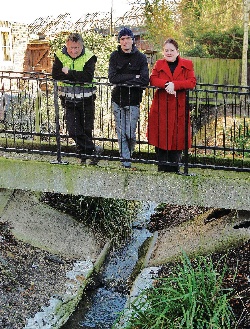
Ian Williamson, Inside Housing’s Alex Turner and Bromford Group’s Sally Wright inspecting culverts
‘I got flooded really badly in 2007,’ she recalls. ‘It came straight in through the kitchen [and] wrecked my lounge carpet. [This time] the ditch started to go. I rang Bromford straight up and they built a makeshift dam to stop water coming in my kitchen - it had got halfway up the doorstep and I thought, “here we go again”.’
The next day Jordan Brown, one of Mr Williamson’s team, removed a blocked pipe at the end of the overflowing ditch, dug up shrubs and extended the channel so water could stream freely away and into a road drain. ‘People here have been really good,’ he says. ‘We’re gardeners, not engineers, but they’re appreciative of us. We don’t just cut grass and trim hedges - we try to save people’s homes.’
Mr Brown’s remedial work is likely to be given a permanent makeover as part of Mr Williamson’s package of recommendations based on the lessons learned this time around.
‘A surveyor can help with the detail… at the moment they’re only rough guidelines - a ditch here, a wall there; six or seven sites,’ says Mr Williamson as we stop for a cup of tea at the landscaping team’s depot - thankfully warm - on our way back towards Tewkesbury. It’s not too often team members get to enjoy such comforts though - they cover an area stretching ‘from Redditch, across to Hereford, down to Bristol, across to Swindon and back up’, so spend most of their time out onsite.
The size of that area prevents us from visiting the two Bromford homes flooded in the recent bad weather - they’re in Cricklade, near Swindon. However, Mr Holder later informs me that damage to the properties was mercifully cosmetic, with the tenants able to remain in their homes while remedial works are carried out.

Mr Williamson
Instead we head back to Fairway to speak to Stacie Slender, 28, who’s moved to the street since 2007 but is well aware that her property was one of the homes flooded that year. Like the other tenants we chat to, she’s grateful for the work carried out by Mr Williamson’s team - yet remains concerned at the potential for further problems.
‘A couple of times when it’s properly rained, water gushes out so fast the whole [culvert] fills with water - it’s like turning a tap on,’ she says. ‘The other day it was quite bad - I actually thought the house was going to flood, and started putting most things upstairs.’
In the end the sandbags provided by Mr Williamson to cover air vents at the property proved unnecessary. And it’s hoped the new wall suggested by him will prevent Ms Slender from having to cart her furniture upstairs in future.
As Mr Williamson acknowledges though, with climate change increasing the likelihood of extreme weather becoming commonplace, such measures represent incremental rather than total solutions for landlords with stock in areas such as Bromford’s.
The housing association does not hold information on how many of its properties are built on flood plains, and while the Environment Agency’s national flood risk assessment mapping gives an indication of risk, it is only a guide, explains Mr Holder.
‘Hopefully we’ve dealt with the worst scenarios,’ he says. ‘But there will continue to be improvements made, because the water keeps on moving somewhere else.’
Wherever that ‘somewhere else’ is, members of Bromford’s landscaping team are likely to be heading in that direction too.

In numbers
111 per cent
in November 2012 rainfall totals for the UK were 111 per cent of the long-term average
x2
some places in a band running between Devon and Humberside had up to twice their normal amount
8th
November 2012 was the eighth wettest on record, in a series that began in 1910
1,331mm
the total rainfall for the UK during 2012 was 1,330.7mm (52.4 inches), just 6.6mm short of the record, which was set in 2000
